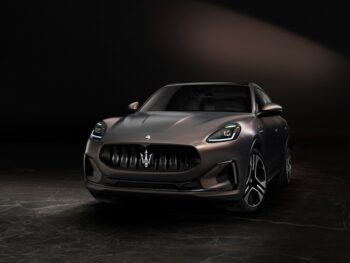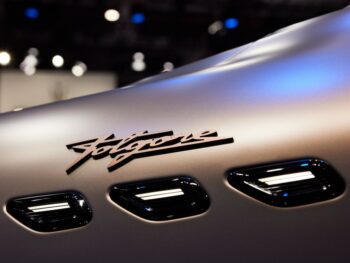BEVissima! – Maserati and its fleet ambitions
Peter Charters, Maserati North Europe’s general manager, has the fleet market in his sights as the Italian carmaker rolls out its Folgore BEV sub-brand.
 Where does Maserati find itself in 2024?
Where does Maserati find itself in 2024?
PC: Last year was an extremely busy year for us – arguably the most important in our recent history because we had our first full year of Grecale SUV. Then, as we moved towards the end of the year, we turned our focus towards the BEV version under the Folgore umbrella and delivered our first left-hand drive models. In the same way that Grecale was a gamechanger for us, BEV, as a whole, will have a similar impact. We’re going straight there from ICE to EV – no plug-ins.
Why no hybrid option?
PC: It’s a deliberate strategy because we wanted to give drivers the full Maserati experience, not a compromised one and, in our view, a plug-in hybrid would be a compromise. We’ve now opened order books for GranTurismo and Grecale Folgore models in the UK, which is really exciting. We’ve seen how some other brands have increased volumes with EVs and we believe that the market is there. Even at the top – price-wise – of the market.
What are your hopes for getting Maseratis into fleets?
PC: We’re not a manufacturer that sets ourselves volume objectives, but we’re looking to pull as many customers as we can into the brand – retail and fleet. In the last few years, everything has been very retail-based, but now we are focused on fleet – moving there in a controlled way. We have no financial pressure on us to move metal, that’s not the objective; it’s more about high-quality customer experience. We’ve got the two BEV options now, but GranCabrio will be arriving – in ICE and BEV form – by May. It won’t be huge volumes, but it’s an important and iconic car.

How do you convince Maserati drivers to get into an EV?
PC: Our strategy is to run with both ICE and EV in the short to medium term to give people options – and it’s fair to say that there are a lot of drivers who just don’t want a quieter engine. We bring our customers along with us, give them the Maserati experience and slowly, over time, convince them that the future is actually pretty exciting – even in a BEV. We talk about how the GranTurismo Folgore drives and corners like a Maserati – it’s still an exciting vehicle, with the luxury and performance that drivers expect from one of our cars.
In time, every version of a Maserati will have a Folgore variant. The one word that we would use to describe how Maserati operates is audacious. We’re really keen to harness what makes Maserati different from other brands and we think it’s summed by the Italian audacity to make brave choices. The current move to electrification was similar to the introduction of diesel years ago, which turned out to be extremely successful.
What involvement do you have with the wider Stellantis family?
PC: Back office-wise, there are some touch points – and there’s long-term engineering and industrial work, which gives us massive confidence because we have the strength of a global player to make the right investment choices. If you go back 10 years, we made some very bold decisions and significant investments, but that was a five-year plan, with some degree of uncertainty.
Day-to-day, as a team – and within the dealer network – we have virtually nothing to do with Stellantis. The dealer network is separate and we make our own decisions. We’re obviously focusing on a very high quality, luxury and customer experience – on an even greater level than the other brands.
What will the Folgore range look like, compared with the current Maserati model line-up?
PC: There will be an electric replacement for the Ghibli Quattroporte, which is coming in 2025, but anything beyond that we can’t comment on. However, it’s fair to say that we made a commitment that everything will be electric by 2030.

What aspirations do you have for both the Grecale and GranTurismo Folgore?
PC: Grecale will be the volume product because it is the less expensive and GranTurismo will absolutely be a premium product. But there are a lot of fleet drivers prepared to pay for GranTurismo, particularly with the BiK advantages for a high-end, luxury car. So I have high expectations of GranTurismo, even in the competitive fleet market.
There’s a great amount of interest in Grecale from the corporate world as a premium electric vehicle and we expect it to do a great job in terms of that community. Our strategy of engagement with the right key players in the industry has to be right, though.
Where are you expecting conquest business to come from for Folgore models? PC: For potential Grecale drivers in the fleet world, there are already players out there, so we have the chance to conquest directly from other high-end BEV vehicles. Also, we think we’ll take some new customers along with us, either ex-Maserati customers, or people who are not quite ready to go with a German or Chinese brand.
We spent a lot of time thinking about our strategy of engagement with fleets, such as identifying the right leasing companies to partner with and – in terms of salary sacrifice – businesses to cut through to get the right drivers. We’re fortunate that a number of our dealer partners have excellent corporate teams too, such as Sytner, H.R. Owen, Hendy and JCT 600 – all of whom are used to operating in the corporate arena.

How important will fleet be in the short- to mid-term?
PC: I think it’ll be a relatively high proportion of our Grecale and GranTurismo sales for Folgore. We still have quite a loyal base of ICE customers, so it’s possible that an MC 20 driver will also buying a BEV, because they’ve always got more than one car. It will be incremental to our business – and obviously, we want to hold on to these customers – but I think for Folgore, fleet will dominate slightly over retail. Only time will tell.













Leave a comment